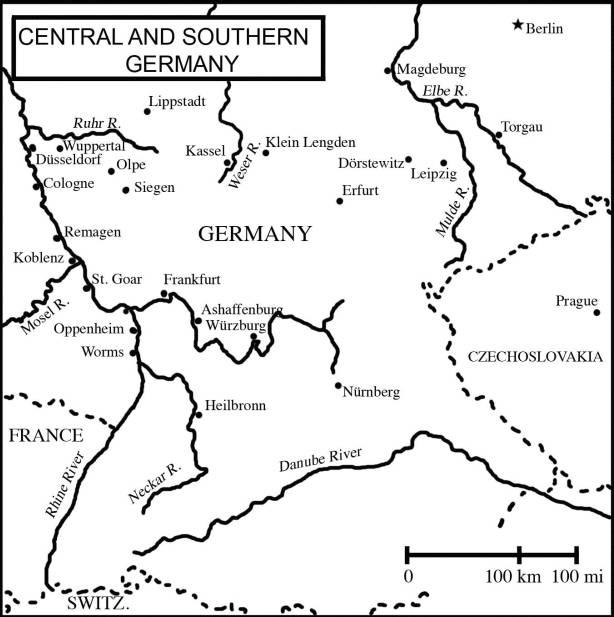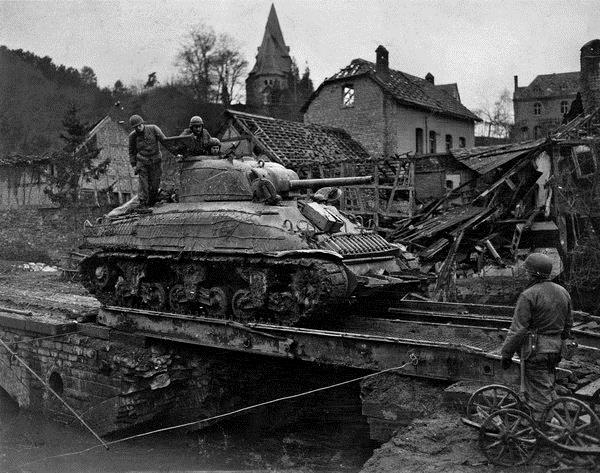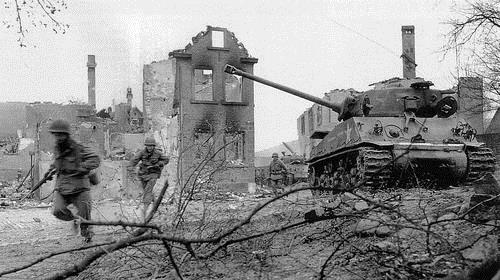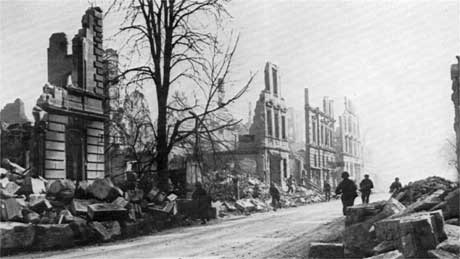
After a bit of an absence, I am most pleased to return control of the keyboard to Harry Yeide. He has come up with a rather topical point of discussion. Over to you, Harry:
US Army tankers, by late March 1945, when the final surge into Germany began, were among the most savvy graduates of the school of war. They knew how to storm cities and deal with small groups of defenders in villages or at crossroads. They could slog through fortifications and run like the cavalry of old. By and large, they had worked out effective teamwork strategies with the infantry, tank destroyers, and artillery, even if still a bit ambivalent about their friends in the fighter-bombers above them. They had learned to beat better tanks and worked out a series of pragmatic technical solutions to problems ranging from communication to moving on ice.
The German Army fought on like a body without a brain—OKW records show it was often a couple days behind developments on the battlefield, and headquarters at all levels had difficulty delivering orders to units that often existed only on paper. Lt. Gen. George Patton’s G-2 shop estimated that as of March 17, total German tank strength on the western front amounted to the equivalent of a single full-strength panzer division.1 As of March 31, the entire force of panzers and assault guns in Third Army’s sector was estimated at only 55 vehicles, all opposite XX Corps in the Fulda area.2
Cornelius Ryan captured the essence of the final push: “The race was on. Never in the history of warfare had so many men moved so fast. The speed of the Anglo-American offensive was contagious, and all along the front, the drive was taking on the proportions of a giant contest.”3 So fast, indeed; between April 24 and 30, the 737th Tank Battalion moved 520 miles.4
The Ninth Army pounded in the direction of Berlin all the way to the Elbe River. Just to the south, First Army advanced to the Mulde River. Patton’s Third Army drove toward Czechoslovakia, and Seventh Army pushed through Bavaria toward the rumored Nazi National Redoubt in the Bavarian Alps and Austria.5
The tankers rolled past columns of German POWs heading for the rear, often with no supervision. Increasingly, displaced persons and released Allied POWs also appeared.

Spearheads
Armored divisions rolled, and because there were not enough to sweep everywhere, some infantry divisions with their attached tank battalions joined the spearheads. Doughs piled onto the tanks. In some cases, artillery observers rode with the forward elements. Tank battalions attached to the infantry divisions in the following wave spent their days scooping up wandering German soldiers and clearing out the scattered towns and villages where German forces refused to give up.
On March 30, 3d Armored Division relayed orders to the 703d Tank Destroyer Battalion to support the attack by the division on the road junction at Paderborn, the Fort Knox of the panzer arm. German instructors, officer cadets, and trainees drove their remaining tanks—including some sixty Tigers and Panthers from an SS replacement battalion—out to contest the American advance, and battle flared across the training grounds for two days.6
Task Force Welborn formed one of the division’s two prongs and was advancing near Etteln at dusk. The column had identified four Royal Tigers ahead, but they had been struck by fighter-bombers, and Col. John Welborn had been assured that the panzers had been knocked out. The column advanced, and the very functional Tigers opened fire with their deadly 88s. Seven Shermans were soon burning.7 The TDs of 2d Platoon, Company B, returned fire and knocked out two Royal Tigers—a job that required thirty-five rounds of AP and five of HE. One 703d recon jeep was destroyed by return fire.8 During this action, division commanding general Maj. Gen. Maurice Rose was killed when he was cut off by four Royal Tigers. A panzer commander, misinterpreting the general’s action, shot him when he reached to drop his holster.9
Belton Cooper, in his history of the 3d Armored Division, reports that Royal Tigers destroyed an entire company of Shermans from an unidentified task force and that one M36 was lost during the debacle.10 The incident is not mentioned in the division’s own history. Several sources concur that one M36 was destroyed that day, but the exact circumstances remain unclear.
The 736th Tank Battalion (attached to the 83d Infantry Division) was one of the units leading the charge. Their column became engaged in an intense rivalry with the 2d Armored Division to see who could move farthest fastest. The doughs requisitioned every vehicle they came across (and one German ME-109 fighter plane, to boot, painting “83d Inf. Div.” across the underside) and soon became known as the “Rag-Tag Circus.” The two divisions reluctantly conceded a tie at the Weser River. Then, on they pelted. The 2d Armored reached the Elbe River late on April 11 and slipped armored infantry across; doughs of the 83d Division reached the east bank of the river on April 13. The 736th Battalion's tanks crossed the Elbe on April 20, but Eisenhower had already decided that his troops would press no closer to Berlin.11 This would be the farthest penetration for a separate tank battalion in Germany.
Advancing columns frequently encountered small units that fought briefly, claiming a few more American lives, before giving up, running, or dying. The SS were a particular problem. American troops had a simple rule: If a town showed white flags and offered no resistance, they rolled through peacefully. If American troops came under fire, they smashed the community. Indeed, any sympathy for the civilian populace declined as advancing forces began liberating the concentration camps. The 70th Tank Battalion’s informal history recorded that “The tanks swept across open fields from village to village, blasting relentlessly at every sign of resistance. Any town or city that tried to delay the advance soon became a raging inferno. The German landscape was dotted with burning villages. More white flags began to appear.” 12
The brand-new German Eleventh Army and its commander, General der Infanterie Otto-Maximilian Hitzfeld, subordinated to Army Group B, tried to put up a fight against XX Corps’ 80th Infantry Division at Kassel from April 3 to 4. The “army” had been created out of the staff of XI Corps and was to control LXVII, LXVI, and IX Corps. Commander-in-Chief West Albert Kesselring personally oriented Hitzfeld, heretofore commanding LXVII Corps, on his orders to both break into the Ruhr Pocket to link up with the remnants of Army Group B and use some elements to stop the American advance across the Fulda.
In terms of numbers, Eleventh Army looked like one of the strongest armies in Germany. LXVI Corps on its right wing consisted largely of an SS brigade that possessed up to 4,000 men and thirty panzers, plus the 508th Heavy Tank Battalion with between twenty and thirty Royal Tigers. LXVII Corps on the left had the remnants of six infantry and volksgrenadier divisions, plus men from the panzer non-commissioned officers school in Eisenach with twenty panzers pulled from the Henschel works. These tanks had given the 80th Division some trouble as it approached Kassel. However, Eleventh Army had almost no reconnaissance capability, artillery, supply structure, or fuel. It had no contact with Seventh Army to its south and little idea what was going on to either flank.
Hitzfeld pondered his resources and immediately sent a radio message to Kesselring’s headquarters requesting the attack order be rescinded. He knew he could not stop the Americans—who he apparently did not even know were from Third Army—in their advance across the Fulda, and in fact probably could not even delay them. His old corps had already given up bridgeheads across the Fulda south of Kassel on April 3. U.S. First and Ninth Armies that same day were smashing LXVI Corps.

The 80th Division on April 4 entered Kassel. The last radio message from the commander of the city’s defenses said, “Surrounded with the remnants of the garrison in the Truselturm [city center]. No ammunition, no water.” The commander surrendered with 400 men.
Kesselring appeared again and told Hitzfeld the attack toward the Ruhr was off. Instead, he was to attack the Third Army’s flank at Eisenach. LXVII Corps by the evening of April 6 assembled some thirty tanks and assault guns and two battalions of infantry at Mülhausen to attack as ordered. The strike group moved out on the 7th, only to be shredded by fighter-bombers, the feared jabos. Third Army nevertheless credited LXVII Corps with conducting a well-coordinated operation but had no idea which German unit was involved. The survivors retreated, and thus ended Eleventh Army’s real fight with Patton. Under the command of General der Artillerie Walther Lucht from April 7 to 20, it continued to be a notional presence because its zone was extended to include Erfurt and Weimar, both of which Third Army easily captured, the latter without a fight.13
The 702d Tank Battalion, dashing through central Germany with the 80th Infantry Division, described in its after-action report the conditions tankers of most units encountered much of the time:
Throughout the month of April, enemy attempts at resistance were marked by their continued feebleness. At only two periods was there any show of strength, and by late in the month our assault had lost its character, and the only proper description for operations engaged in by the battalion was “road march”.
The cities of Kassel and Erfurt were the focal points of resistance, and in the defense of the former, tanks were used in limited numbers. Flak units were the manpower basis for this defense. But these fanatical sacrifice operations served to no value, for the miscellaneous grab-bag units crumbled before our organized assaults after only a token-plus resistance...
The attitude of the German soldier was one of complete abandonment to his fate. He found his fate lay only in two directions, death or the PW camp, and with a little physical persuasion, generally chose the latter. PW figures grew astronomically, and interrogation degenerated into a simple counting of those who passed through the tills of the PW cage. The German people were completely confused and confusing. Many of them went out of their way to be hospitable to the conquering American, and overt acts by the civilians against our military forces were rare.14
General der Panzertruppe Smilo Freiherr von Lüttwitz on March 29 received orders to activate the remnants of LXXXV Corps headquarters and assume control of the Werra sector on April 1. Lüttwitz found he had at his disposal the redoubtable 11th Panzer Division, still at 50-percent strength, including 20 to 25 Panthers and Mark IVs, and with good communications. He also had a Kampfgruppe from the armored troops school with five panzers and fragments of three infantry divisions. A panzergrenadier regiment of the 11th Panzer Division supported by 12 panzers formed his only reserve.
The corps was to hold U.S. XII Corps before Eisenach and block entry into the Thuringian Forest, and as best as Lüttwitz could understand the situation, the 4th Armored and 90th Infantry divisions would arrive in his zone in the near future. Lüttwitz planned to wage a flexible defense. He kept the 11th Panzer Division southeast of Eisenach, ready to reinforce an imperiled part of his line or to counterattack any breakthrough.
The instincts were still there, but the means were not. Lüttwitz described the last serious effort by any German commander to fight:
The north wing appeared to be particularly endangered because there was the boundary of the army group and a loose communication with the units to the north of Kreuzburg existed only temporarily. Because of inadequate radio equipment available, signal communications to [Seventh] Army as well as to subordinate and neighboring units had to be established by using the postal telephone wire net, which was mostly overburdened and therefore frequently failed to transmit.
At the Werra sector, only light field positions had been built during the short lapse of time, and only small defense sectors in depth along the main roads. But artillery and antitank defense for an efficient defense were entirely lacking...
By using heavy screening smoke, the American forces crossed the Werra at Kreuzburg and south of it early in the morning of April 4. From the bridgehead newly formed by infantry, the spearhead of the American 4th Armored Division thrust past the north of Eisenach to the east [...] In the afternoon of the 4th, the American 90th Infantry Division attacked on a wide front against the sector south of Eisenach [...] During these engagements, the corps (exclusive of the 11th Panzer Division) lost about 60 percent of its fighting strength. [Lüttwitz had been forced to commit the 11th Panzer Division on his right flank and so it was not available to counterattack as he had planned. By April 9, all formations subordinate to the corps had been annihilated except for Wietersheim’s division.]15
Responding in part to the “extremely stubborn” resistance at Eisenach, the Third Army G-2 Oscar Koch observed, “Apparently as long as the German High Command is able to conjure up personnel that will submit to commitment it is the purpose of the High Command to wage war [...] The bulk of the enemy’s armies have been shattered and his industrial power to continue large-scale warfare has been either destroyed or captured. But his will to fight and fanatical ingenuity to inflict losses on us are unshaken. The enemy is comparable to a mad beast at bay—wounded to the death but still deadly dangerous.” On April 11, Koch judged that some 16,000 men and perhaps ninety tanks and assault guns opposed the quarter-million men of Third Army.16
Indeed, now and again, the fights were big and dismaying.
Aschaffenburg
On March 28, the 45th Infantry Division arrived at Aschaffenburg, which proved to be the first of several tough urban battles. Army Group G was attempting to construct a line along the Main River and had transferred LXXXV Corps from First to Seventh Army to execute the mission. OKW had ordered the 413th Division, slapped together from training units, to reinforce positions north and south of Aschaffenburg. The army group was hurriedly refitting the 36th Infantry and 17th SS Panzergrenadier divisions from its dwindling stocks and planned to bring them forward as soon as possible.17

The 45th Division crossed to the east bank of the Main River and found an organized defense anchored in pillboxes and trenches and backed by artillery and mortars. The GIs encountered elements they initially identified as the 553d Volksgrenadier Division, although a German account indicates the troops belonged to the 413th Division. The 2d Battalion, 157th Infantry Regiment, which had crossed the Main over a railroad bridge, attacked Aschaffenburg, where it encountered heavy small-arms, machine-gun, and antitank fire that slowed the advance to a painstaking crawl.18
After getting a first taste of the resistance, the division reported that an estimated 3,500 “Krauts” were in Aschaffenburg.19 The division’s AAR records the following for March 29: “Enemy resistance [...] soared to a peak of fanaticism [...] Civilians without [Volkssturm, or militia] armbands fighting in Schweinheim and Aschaffenburg necessitated searching every house and building. Enemy reinforcements arrived steadily, and elements of the 36th Infantry Division were identified. Many of the enemy soldiers were 16- and 17-year-old boys who refused to surrender and had to be killed in their foxholes and trenches.” The division’s history added, “[Garrison commander] Major von Lambert organized old men, women, and young girls to resist the division’s advance. They hurled grenades from roofs and second-story buildings.” (Von Lambert had permitted all civilians who wished to leave to do so by March 29.)
The 2d Battalion pounded Aschaffenburg while tank destroyers fired at a church steeple serving as an OP and at strongpoints, and numerous fires flared around the city. The 3d Battalion struggled to clear nearby Schweinheim to open a route that would allow the regiment to envelop Ashaffenburg from the east. Three battalion-size counterattacks hit the Americans in the course of the day before the Germans withdrew to the northern part of town.
Commanders ordered up air strikes against targets in Aschaffenburg the next day, including von Lambert’s headquarters in the Gestapo building, and a chemical mortar battalion rained white phosphorus on the city, igniting yet more blazes. The 3d Battalion managed to reach the last row of houses in Schweinheim by dusk, but German troops reinfiltrated behind the Americans. As a result, when the 2d Battalion moved forward for a day of house-to-house fighting in Aschaffenburg, the 3d Battalion had to refight the battle in Schweinheim.
Finally, on April 2, the regiment was able to commit all three of its battalions to Aschaffenburg, which continued to shudder under air and artillery bombardment. 155mm self-propelled guns were brought into the city to fire point-blank into buildings. At 0900 hours on April 3, von Lambert approached the lines of the 2d Battalion and capitulated. One German officer estimated that the defenders had suffered 1,500 personnel killed and wounded, and another 3,000 were taken prisoner. The GIs, recalling their toughest fight in Italy, henceforth called the ruined city “Cassino-on-the-Main.”20
The Germans had expended almost everything they had in front of XV Corps at Aschaffenburg. From here, the Americans would encounter almost no organized resistance until they had reached Nürnberg.21 Irreparable holes had emerged between Army Groups G and B, and between the armies within Army Group G.22
Heilbronn
After Seventh Army crossed the Rhine, the 100th Infantry Division and the 781st Tank Battalion advanced rapidly until reaching the west bank of the Neckar River in the vicinity of Heilbronn on April 3. The doughs crossed the river in assault boats the next day to find themselves battling a remarkably effective defense made up of Wehrmacht, Volksturm, Hitler Youth, and SS—so effective that the Germans counterattacked and almost threw the doughs back into the Neckar. Accurate artillery fire disrupted every American attempt to erect a bridge and get the tanks across. Higher headquarters frantically arranged for the delivery of 10 DD Shermans to the 781st Tank Battalion, and crews were given a day of training. The tanks entered the water but were unable to climb the other side, and three sank. Finally, on April 8, two platoons made the trip across a temporary bridge that was immediately knocked out by enemy artillery. On April 12, American doughs and tanks pushed the German artillery out of range of the bridging sites, and on the next day Heilbronn fell.23

Crailsheim
Also in Seventh Army, a 10th Armored Division envelopment operation turned into a bit of a fiasco. Combat Command A easily rolled 30 miles into Crailsheim on April 6, where a task force occupied the town while two others pressed on. Small groups of German troops, probably from the 1st Alpine Regiment that had by chance just arrived in the area, slipped behind the command and closed the single narrow road that was the armored outfit’s supply line. Perhaps because the Luftwaffe saw no point in hoarding fuel or aircraft, air strikes by German fighter-bombers increased as Allied forces progressed deeper into the Reich. Me-110 bombing runs against the troops in Crailsheim that day suggested that there was still some coordination going on with ground forces, and more air attacks in support of ground assaults took place over the next several days.
“For four days,” noted Stars and Stripes, “the fighting at the tip of the Crailsheim finger was the most bitter along the Western front.” Brooks had to commit CCB from corps reserve along with a cavalry squadron and an infantry regiment from the 44th Infantry division to flush the German combat groups from the length of the road and the villages along side it, which took until April 10.
Inside Crailsheim, as many as 700 SS troopers from a school at Ellwangen attacked Combat Command A on April 8 from three directions and inflicted numerous casualties. When 60 C-47 transports were ordered to land at the captured Crailsheim airfield to deliver supplies and evacuate casualties on April 9, German fighter-bombers appeared and strafed and bombed the aerodrome. A battalion-size SS force attacked the Americans again on April 10. Once the 10th Armored Division linked up with the 63d Infantry Division, which had also had a rough time with the SS, it abandoned Crailsheim rather than fight to hold the unimportant town. Within a day after Heilbronn’s capture, the SS had largely been wiped out or slipped away.24
According to a fairly substantial body of German post-war accounts, after this and other stiff actions involving the SS—at a time when the war was clearly lost, and GIs increasingly resented the idea of being killed for no good reason—some American troops summarily executed groups of captured SS men.25 It is possible that the liberation of a growing number of concentration camps also contributed to these ugly violations of the rules of war.
Nürnberg
On April 17, the 756th Tank Battalion rolled into the Nazi citadel of Nürnberg, and with the doughs of the 3d Infantry Division for three days fought street to street against determined resistance in the form of antitank, bazooka, and small-arms fire. The 191st Tank Battalion and 45th Infantry Division pushed in from the south. SS and mountain troops, backed by 35 tanks brought from the Grafenwoehr Proving Grounds, defended the city. German snipers with panzerfausts picked off tanks from the rooftops, and it became standard practice for the tanks to blast any building that even looked as if it might hide such a sniper. On April 22, with victory finally at hand, the 756th Tank Battalion patrolled the streets of the city in a show of strength.26
1Third Army G-2 periodic report, 17 March 1945.
2Third Army G-2 periodic report, 31 March 1945. Army Ground Forces Report No 808, “Tank Destroyer Information Letter No 8,” 4 April 1945.
3Cornelius Ryan, The Last Battle (New York: Simon and Schuster, 1966), 280. (Hereafter Ryan.)
4AAR, 737th Tank Battalion.
5Griess, 406–407
6Ibid., 352. Wilmot, 684.
7Charles Whiting, The Battle of the Ruhr Pocket (New York, NY: Ballentine Books Inc, 1970), 62-63. (Hereinafter Whiting, The Battle of the Ruhr Pocket.)
8S-3 Journal, 703d Tank Destroyer Battalion.
9MacDonald, The Last Offensive, 352.
10Cooper, 254-256.
11Ryan, 285 ff; Macdonald, The Last Offensive, 387. AAR, 736th Tank Battalion. AAR, 709th Tank Battalion.
12Soixante-Dix.
13Schramm, Kriegstagebuch der OKW, 1. Januar 1944—22 Mai 1945, Zweiter Halbband, Band 4, 1225ff. Oberst Fritz Estor, “Kaempfe der 11. Armee April 1945 in Mitteldeutschland,” MS # B-581, 3 January 1947, National Archives, passim. Third Army G-2 periodic report, 1-12 April 1945.
14AAR, April 1945, 702d Tank Battalion.
15General der Panzertruppe Smilo Freiherr von Lüttwitz, “Combat Report of the LXXXV. ‘Armeekorps’,” MS # B-617, June 1947, National Archives, 1ff. (Hereafter Lüttwitz, “Combat Report of the LXXXV. ‘Armeekorps’.”)
16Third Army G-2 periodic reports, 5 and 11 April 1945.
17Wilutzky, “The Final Battle.”
18AAR, 45th Infantry Division.
19G-3 journal, VI Corps.
20AAR, 45th Infantry Division. The Fighting Forty-Fifth, 162 ff.
21G-2 history, Seventh Army.
22Wilutzky, “The Final Battle.”
23Battalion history, 781st Tank Battalion. Up From Marseille, 22; Whiting, 193 ff.
24Report of operations, Seventh Army. Battalion history, 781st Tank Battalion; Up From Marseille, 22; Whiting, Whiting, America’s Forgotten Army, 193 ff. G-3 journal, VI Corps. Wilutzky, “The Final Battle.” Terrify and Destroy: The Story of the 10th Armored Division (Paris: Stars and Stripes, 1945). Generalmajor Wolf-Rüdiger Hauser, “Report on the Combat Engagements Within the Framework of the First Army During the Period From 24 March to 2 May 1945,” MS # B-348, 12 September 1946, National Archives. (Hereafter Hauser.)
25Search for “warcrimes,” Axis History Forum, www.axishistory.com.
26AAR, 756th Tank Battalion; Whiting, 197 ff.
 |
 |
 |
